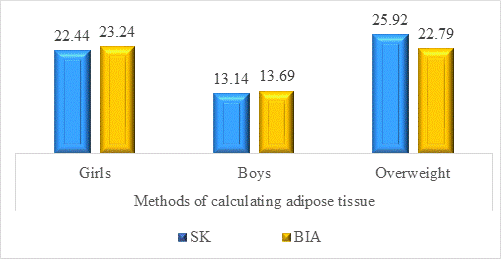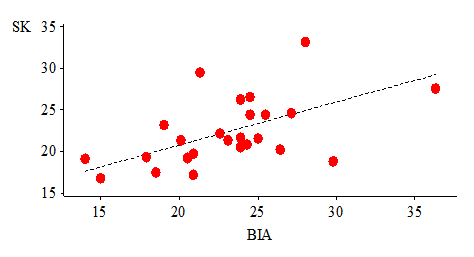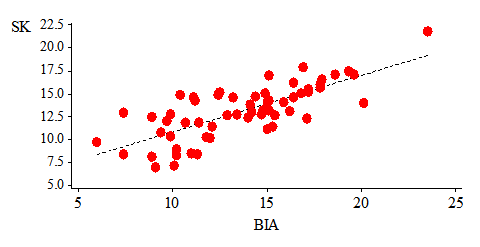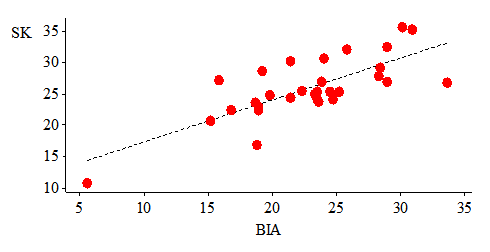Abstract
Body composition is a much debated topic in today’s modern society, where sedentariness and obesity are two phenomena with alarming global growth rates that affect the health of individuals, who are exposed to a high risk for certain diseases, including diabetes. The research aimed to assess body composition by using simultaneously two methods of indirect assessment of young students: Tanita Bioelectrical Impedance Analysis monitors versus Skinfold calliper measurement (5 sites). It should be noted that certain studies have emphasised that Tanita has the best accuracy in the assessment of body composition compared to other similar products on the market. This is a fast and safe technique that has become very popular due to its ease of use. The research was conducted within the UPB Sports Complex between 2 October and 20 November 2017. There were investigated 120 young people (30 female and 90 male) aged 19 to 23 years, among them being a group of young people showing overweight, according to their BMI. There were recorded very high-intensity correlations between the adipose tissue values obtained by using the two methods for both groups (boys and girls). In the case of overweight subjects, there are statistically significant differences between the mean values corresponding to the adipose tissue calculated by both methods.
Keywords: Body compositionskinfold calliperbioelectrical impedance analysisobesity
Introduction
In the conditions of modern life, which offer various areas of interest and lead to sedentariness and implicitly obesity, body composition analysis is important, because it provides valuable information on the ratio between fat mass and active mass, which is constantly changing throughout the lifespan. After the age of 30, muscle tissue is decreasing and shows the highest variations, being replaced by fibrous connective tissue and adipose tissue. In this context, the role of physical education and sport increases considerably, because the formation of young people’s conviction to practice physical exercises throughout their lives can combat these phenomena (Leonte & Popescu, 2014). The analysis of an individual’s body composition is essential in the assessment of obesity, because the Body Mass Index (BMI) does not provide information on the ratio between active mass and passive mass; thus, in practice, we often see active individuals with developed muscle mass, who have an increased BMI without excessive adiposity, as well as situations where people with a normal BMI have excessive body fat. For this reason, numerous methods of indirect body composition assessment have been developed, among which we mention: DXA (Dual-energy X-ray Absorptiometry), BIA (Bioelectrical Impedance Analysis), Skinfold (SK) thickness test, MRI (Magnetic Resonance Imaging).
Over time, comparisons between various methods of determining body composition have been addressed by specialised studies, for different segments of the population. Thus, the study achieved by D’Alonzo, Aluf, Vincent and Cooper (2009) shows that no significant differences have been found between the percentages of adipose tissue obtained by BIA and Skinfold methods in sedentary women.
Ostojic (2006) has highlighted that estimates of body fat in top-level athletes were similar between SK and BIA, with significant correlation (r=0.96) between methods, but the BIA method is less time-consuming.
The study of Kęska et al. (2012) shows that the anthropometric and BIA methods provide different results of body fat content, especially in women, so they should not be used interchangeably.
In another study conducted by Suarez-Arrones et al. (2018) on soccer players, three methods of body composition assessment are used, the authors stating that these different methods are likely to differ, so they cannot be used interchangeably. According to these authors, almost all the equations showed positive correlations, but with different values compared to a recent DXA model.
In the study of McRae (2010), there was no significant difference between Skinfold measurements (4 skinfold sites) and BIA when estimating percentage body fat for men; but the difference was significant for women, where BIA underestimated by 3.4%.
Another study (Grove, 2015) shows that Skinfold and BIA measurements significantly underestimate percentage body fat compared to DXA measurements for body composition.
The study of Lubis, Yiin, and Luftimas (2018) has revealed that there are no significant differences between the results of the two methods (BIA and Skinfolds) in the case of the group of teachers, regardless of gender, training level and BMI, except for the obesity-1 class of teachers.
Body composition analysis is indispensable in assessing fitness for life – an expression that highlights the need for a rational lifestyle, where physical activity is an indissoluble part.
Problem Statement
This study uses two methods of indirect body composition assessment, which are meant to help analyse the obtained results, and the use of new technologies in the field stimulates and arouses the students’ interest in the internal screening of their body tissues and implicitly in maintaining optimal muscle tone, thus becoming more aware of the need for physical activity in the light of their future professional careers.
Research Questions
In fitness rooms, the BIA body analysis method is very popular, which is why this paper investigates the correlation between BIA results and the 5-site Skinfold test in young people.
Purpose of the Study
The research aimed to assess body composition by using simultaneously two methods of indirect assessment of young students: Tanita Bioelectrical Impedance Analysis monitors versus Skinfold calliper measurement (5 sites), in order to compare the results obtained by different groups of young people
Research Methods
Subjects
To conduct the experimental research, there were selected subjects aged 19 to 23 years, of both genders, participants in the physical education classes at the Politehnica University of Bucharest (UPB), from 2 October to 20 November 2017. The selected subjects gave their written consent to take part voluntarily in the research.
The study included 120 young people who were divided into three groups: the first group had 60 young men, the second group consisted of 30 young men with a BMI indicating overweight/obesity, and the third group was made up of 30 female participants.
Methods
This study used the following research methods: bibliographic study, Bioelectrical Impedance Analysis, Skinfold thickness test, mathematical and statistical method, graphical method.
To assess body fat, the Skinfold thickness test was used (Grove, 2015) for 5 sites (abdomen, flank, subscapular, triceps brachii, thigh), and the body surface was calculated with the Dubois and Dubois nomogram; measurements were performed with a calliper used in sports medical practices; in parallel, body fat was also assessed by the BIA method, using the Tanita FitScan BC-601 device, which is thought to have, according to some specialised studies, the best accuracy in the assessment of body composition compared to other similar products on the market. It should be noted that both assessment methods are non-invasive, safe and simple, and that the operating instructions for the Tanita BC 601 device have been followed.
Findings
The statistical indicators per method of calculating body fat for girls, boys and overweight subjects are shown in Table

In the groups of boys and girls, the average percentage of adipose tissue determined by the BIA method is higher than the one calculated by the Skinfold method, the differences being 0.80 (3.6%) for girls and 0.55 (4.1%) for boys. In the overweight group, the average percentage of adipose tissue determined by the BIA method is lower than the one calculated by the Skinfold method, the difference being equal to -3.13 (12.1%). In the case of both methods, the data have a relatively homogeneous dispersion for all three groups. (Figure
In the group of girls, the results obtained from the determination of adipose tissue by both methods show that there are no statistically significant differences between the two methods, p=0.348> 0.05, for t=1.05 and 29 degrees of freedom. The effect size (0.19) indicates a small difference between the average percentages of adipose tissue obtained by the Skinfold method and the BIA method. (Table
In the group of boys, the results obtained from the determination of adipose tissue by both methods show that there are no statistically significant differences between the two methods, p=0.185> 0.05, for t=1.82 and 59 degrees of freedom. The effect size (0.23) indicates a small difference between the average percentages of adipose tissue obtained by the Skinfold method and the BIA method. (Table
In the case of overweight subjects, there are statistically significant differences, p=0.003 <0.05, for t=4.56 and 29 degrees of freedom, between the mean values corresponding to the adipose tissue calculated by using the two methods. The effect size (0.83) indicates a large difference between the average percentages of adipose tissue obtained by the Skinfold method and the Scale method. (Table
We note that there are statistically significant differences between the percentages of adipose tissue determined by both methods, which indicates that the two methods lead to totally different results.
There is a positive correlation between the results recorded by girls for body fat percentages obtained by using the two methods. The correlation is statistically significant, p=0.001 <0.05, for the correlation coefficient r=0.566. The effect size (the coefficient of determination - r2) shows that 32.1% of the dispersion of the results of a method is influenced by the values determined using the other method. It also noted that the effect size indicates high to very high intensity of the correlation. (Table
The distribution of the 30 pairs of SK - BIA data for girls is graphically represented in Figure

In the group of boys, there is a highly positive correlation between the adipose tissue values obtained by using the two methods. The correlation is statistically significant, p <0.001 <0.05, for r=0.756. The effect size (the coefficient of determination - r2) shows that 57.1% of the dispersion of the results of a method is influenced by the values determined using the other method. The effect size indicates very high intensity of the correlation. (Table
The distribution of the 60 pairs of SK - BIA data for boys is graphically represented in Figure

In the group of overweight subjects, it is noted a highly positive correlation between the adipose tissue values obtained by using the two methods. The correlation is statistically significant, p <0.001 <0.05, for r=0.757. (Table
The distribution of the 30 pairs of SK - BIA data for overweight subjects is graphically represented in Figure

Conclusion
Using methods of indirect assessment of the ratio between fat mass and lean mass has increased the level of awareness among young people in higher education, as regards the effects of physical inactivity on their body and implicitly their health.
The average percentage of adipose tissue for both groups (boys and girls) was higher by the BIA method, the differences being 0.80 (3.6%) in girls and 0.55 (4.1%) in boys, but no statistically significant differences were recorded.
There were recorded very high-intensity correlations between the adipose tissue values obtained by using the two methods, for both groups (boys and girls).
In the case of overweight subjects, there are statistically significant differences, p=0.003 <0.05, for t=4.56 and 29 degrees of freedom, between the mean values corresponding to the adipose tissue calculated by using the two methods. The fact that the adipose tissue determined by both methods is statistically significant indicates that the two methods lead to totally different results, but there is a highly positive correlation between the adipose tissue values obtained through the two methods.
Acknowledgments
This paper was funded by Politehnica University of Bucharest, through the “Excellence Research Grants” Program. Identifier: UPB - GEX 2017, Ctr. No. 98/25.09.2017 (EMTASOI).
All authors contributed equally to this study and should be considered as main authors.
References
- D’Alonzo, K. T., Aluf, A., Vincent, L., & Cooper K. (2009). A comparison of field methods to assess body composition in a diverse group of sedentary women. Biological Research for Nursing, 10(3), 274-823.
- Grove, J. (2015). Comparison of skinfold and bioelectrical impedance analysis with dual-energy X-ray absorptiometry for body composition analysis in college students. Retrieved from https://asu-ir.tdl.org/asu-ir/bitstream/handle/2346.1/30403/GROVE-CAPSTONE-2015.pdf?sequence=1&isAllowed=y
- Kęska, A., Tkaczyk, J., Czajkowska, A., Wiśniewski, A., Norkowski, H., Smolarczyk, M., & Kapuściński, P. (2012). Fat content in young adults determined by skinfolds and body composition analyzer. Pediatric Endocrinology, Diabetes & Metabolism, 18(1), 33-36.
- Leonte, N., & Popescu, O. (2014). The importance of somatosensory-functional development in preventing posture deficiencies among students in higher technical education. Procedia – Social and Behavioral Sciences, 117, 81-85. doi: 10.1016/j.sbspro.2014.02.182
- Lubis, L., Yiin, N. N. Z., & Luftimas, D. E. (2018). Differentiation of body fat composition between skinfold calliper and bioelectrical impedance analysis methods among professors. Bali Anatomy Journal (BAJ), 1(1), 12-16.
- McRae, M. P. (2010). Male and female differences in variability with estimating body fat composition using skinfold callipers. Journal of Chiropractic Medicine, 9(4), 157-161.
- Ostojic, S. M. (2006). Estimation of body fat in athletes: Skinfolds vs. bioelectrical impedance. The Journal of Sports Medicine and Physical Fitness, 46(3), 442-446.
- Suarez-Arrones, L., Petri, C., Maldonado, R. A., Torreno, N., Munguía-Izquierdo, D., Di Salvo, V., & Méndez-Villanueva, A. (2018). Body fat assessment in elite soccer players: Cross-validation of different field methods. Retrieved from https://doi.org/10.1080/24733938.2018.1445871
Copyright information

This work is licensed under a Creative Commons Attribution-NonCommercial-NoDerivatives 4.0 International License.
About this article
Publication Date
16 February 2019
Article Doi
eBook ISBN
978-1-80296-054-9
Publisher
Future Academy
Volume
55
Print ISBN (optional)
-
Edition Number
1st Edition
Pages
1-752
Subjects
Sports, sport science, physical education
Cite this article as:
Braneț, C., Pelin, R., Florescu, O., & Leonte, N. (2019). Comparative Study On Body Composition Determined By Bioimpedance And The Skinfold Test. In V. Grigore, M. Stănescu, M. Stoicescu, & L. Popescu (Eds.), Education and Sports Science in the 21st Century, vol 55. European Proceedings of Social and Behavioural Sciences (pp. 185-192). Future Academy. https://doi.org/10.15405/epsbs.2019.02.23
